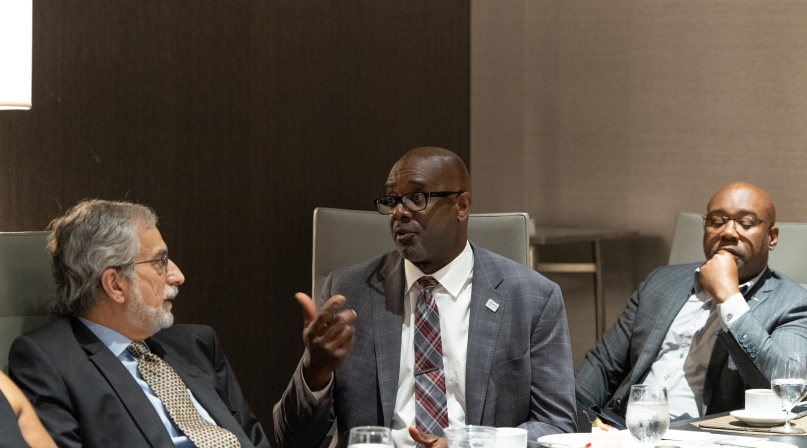Urban county leaders discuss workforce development

Key Takeaways
Leaders from NACo’s Large Urban County Caucus (LUCC) gathered June 14 in Washington, D.C. to share how their respective counties are bridging the workforce development divide and discuss policy solutions.
The county leaders received data on workforce development at the county level from Kevin Shrawder, NACo senior analyst for economic and government studies, and also heard about policy solutions from Michael Matthews, NACo legislative director of community, economic and workforce development, before meeting with U.S. Department of Labor officials to discuss ways counties can partner with the federal government to support workforce recruitment.
County governments employ more than one in 50 workers in America, but with an aging workforce (what some call “the silver tsunami”) and the cultural shift to a hybrid workplace, local government employment is one of only two sectors that has not returned to pre-COVID levels.
Matthews outlined policy solutions for county workforce recovery:
- Increasing federal investments in America’s workforce
- Modernizing the current national workforce development system and landscape
- Eliminating barriers to education and employment
- Broadening access and strengthening the intergovernmental partnership.
The importance of investing more in trades — and making it more widely known as an option for America’s youth — came up repeatedly in discussion. Nearly half of Americans over 25 don’t have post-secondary training credentials, which consists of a college education or trade and vocational training.
“ARPA (the American Rescue Plan Act) has been a godsend and, if not for ARPA, there’s so much we would be in a bigger hole with, but the reality of it is, with Pell Grants we need to think about also using those for certificate programs, not just the standard university scholarships,” Harris County, Texas Commissioner Adrian Garcia said. “… We need a different strategic look at the existing resources that the federal government provides our respective workforces.”
Local governments have had the hardest time filling positions in healthcare, specifically nursing, since the onset of the pandemic, according to NACo data. As a result, Baltimore County, Md. is partnering with its community college system and the University of Maryland medical system to fund a 30-person nursing cohort that provides stipends for everything from transportation to childcare to housing.
“We are basically guaranteeing work, for an employer who needs it in the hospital system, but also for our residents,” said Baltimore County Executive Johnny Olszewski. “So, we’re taking folks, who are in many cases, maybe a high school dropout, and at the end of two years, they’re going to go from potentially being on services and having support from the government to being in a place where they’re in a family-sustaining job.”
Eliminating barriers to workforce training and prioritizing historically disadvantaged populations, such as people with disabilities, formerly incarcerated individuals and people of color, particularly women, were also identified as important paths forward in addressing workforce development gaps.
Programs that were highlighted in this area include a Harris County, Texas family-friendly workplace program, which offers paid parental leave, infant sick leave, childcare access, breastfeeding support and mental health support for county employees to both better serve its workforce and compete with private employers with the changing workplace. Another program that was also highlighted is in Hennepin County, Minn. Its “community productive day” program, which provides training and education to justice-involved individuals, connects them to community-based staffing agencies and employers.
“Rethinking who is in the pool of potential employees and tapping into communities who are marginalized and traditionally kept out of higher paying, good union jobs … the county, what we’ve done is develop the ‘community productive day’ program to remove all of those barriers and prove that these are people who are just as employment-ready and skills-capable as anybody else,” said Hennepin County Commissioner Angela Conley. “Rather than viewing them as people to be pitied, we’re investing in them and their long-term employment skills and self-sufficiency.
“We are all very familiar with the fact that skilled labor is hard to find and retain, so we’re targeting that portion of the employment base that’s too often disregarded and making sure that they are a cornerstone to our overall regional workforce strategy,” she noted.
DOL officials pointed to specific grants, including the Equitable Transition Model (ETA) Strengthening Community Colleges program and the Incarcerated Veteran Re-Entry program, and the state exchange on employment and disability — which provides direct assistance on how local governments can set up disability hiring initiatives — as ways counties can receive federal help financially in overcoming barriers in workforce development.
LUCC leaders then went to Prince George’s County, Md. to hear how the county’s partnership with the MGM resort casino is developing its local workforce through investing in both the training pipeline and in small, minority-owned businesses in the county.
“Prince George’s County every year in income taxes loses $7.5 billion because that’s how many people live in our county, but don’t work here,” said Kerry R. Watson Jr., regional vice president of Government Affairs at MGM Resorts International.
MGM National Harbor is hoping to make a dent in that number by creating more livable wage jobs for people who actually live in the county. In accordance with its partnership with the county, roughly half of the casino’s 3,200 employees are Prince George’s County residents, according to Watson.
“There are jobs [at MGM] that literally only require a high school diploma, but people are making upwards of $60-, $70-, $80,000 a year,” Watson said. “These are jobs with benefits, they are union represented — whether you have extended education or very little education, there’s really an opportunity to make a livable wage being employed here at all levels.”
To broaden their reach, MGM partnered with local universities on expungement events, which consist of going into areas with high rates of criminal justice-involved individuals and helping people get their non-violent drug charges expunged so that they can then be connected to skills training for employment.
“The county was involved in us assuming the presence of the training center in an elementary school that was closed and refabricated for a training facility specifically for the gaming industry here, for a $1 lease,” Watson said. “… About 33% of our operational spend is on diverse companies and that is very intentional. We look for, identify and support through additional programming our small and diverse businesses and we pay particular attention to small minority businesses from Prince George's County.”
Attachments
Related News

Professional Development Academy and National Association of Counties launch expanded partnership to support local government leaders
Professional Development Academy and NACo expand their partnership to train 10,000 more county leaders, equipping officials with critical leadership and tech skills.

